
June 16, 2002
James Cannon actively served 12 years in the U.S. Army with a broad range of experience from programming COBOL on a mainframe, to networking simulators with UNIX, and supervising a small IT shop. He continues military service in the U.S. Army Reserve. He is currently working for Agilent Technologies as a "Technical Lead" overseeing the backup operations of 5000+ HP-UX and Windows clients. He is happily married, a proud father, and never gets enough keyboard and mouse time with OS/2 Warp.
If you have a comment about the content of this article, please feel free to vent in the OS/2 eZine discussion forums.
There is also a Printer Friendly version of this page.
|
Previous Article |
|
Next Article |

Post-install Networking
At one time, networking was exclusive to business environments where a need to
share data increased at an alarming rate. For the past few years, networking
has made its way home. Whether it was connecting the "old" computer to the "new"
one, or accessing broadband service. If you're like me, you may have networked
computers at home just to understand the process of it. Probably way before DSL or
other technologies. Maybe you've bought a new computer with all the latest and
greatest stuff, but you want to access that old system still. As you know,
migrating a system to new hardware is a pain. Hence, the term "legacy systems".
Perhaps you've installed OS/2 Warp and never added networking. Well, there is
only one place to go, System Setup (located in your "OS/2 System" folder on the
Desktop). Once there, you'll need to drill down to "Install/Remove", and start
"Selective Install for Networking". Sound straightforward enough? It is.
That is the way it was designed to be. Now, for a minute, forget all the hype
about "how hard OS/2 is to configure". It isn't. Once you open "Selective
Install for Networking", you'll be greated with a wizard to guide you through a
sequence of dialogs. Please see below.
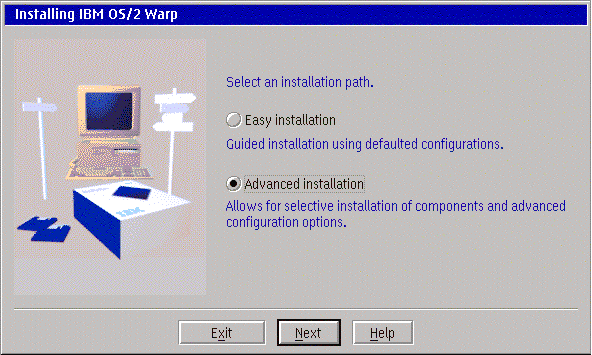
Now, if you're the adventurous type, or are intimidated by words such as "Easy installation", you'll select "Advanced installation" and continue. So far so good? OK! Onward. Now we get to the actual choices of networking possibilities. If you just need to share files, select "File and Print Client". This is the protocol called NETBIOS. I won't get into further details, as there are references that can better explain NETBIOS. This will let you connect to Windows systems and Linux/Unix systems running SAMBA. Windows uses a superset of NETBIOS called NETBEUI (NETBIOS over TCP/IP). For Unix networking, AKA the internet protocol, select, "TCP/IP Services".

Once you've made your choices, you need to configure them. But, you already knew that. If you haven't made your choices, you can always use the "Previous" button. In any case, when you are ready to continue, you should see something like the following:
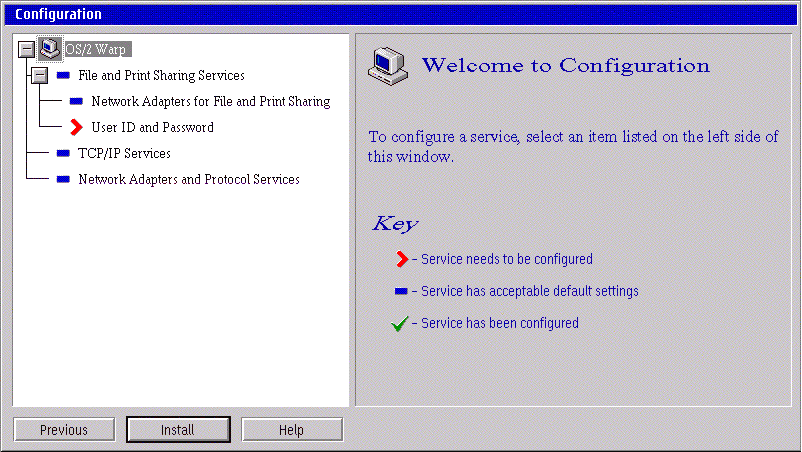
On the left, you see your previously made choices, and icons associated to their status. This will lead us to the right side with an explanation. As it is, "File and Print Sharing Services" (AKA peer networking) is broken and needs attention. At this point you'll also notice TCP/IP Services are OK. That is because this is the default - to access the internet with a modem! If you didn't have peer networking to configure, you could be reading this article now! Bad joke. So, let's drill down each one and configure as we go. That way you won't forget something and end up beating the horse you rode on.
File and Print Sharing Services
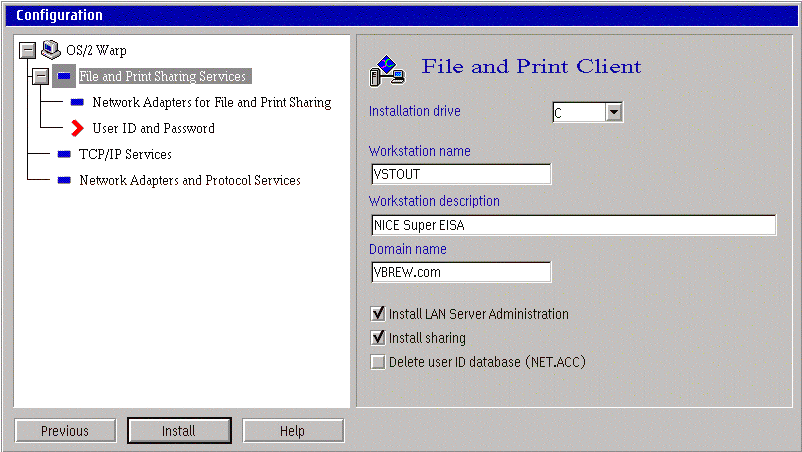
Just fill in the "Workstation name" with whatever suits your fancy. I choose VSTOUT (some of you may find that familiar if you've read the "Linux Network Administrator's Guide, see references below). Then you will need to fill in the Domain name. Microsoft Windows defaults to "WORKGROUP". OS/2 defaults to "IBMPEERS". They are different. Believe me. What now? Make them match! Questions? (please place them in the forum). A bright mind will have noticed I goofed and had to redo it. I first put in VBREW.com, but should have used VBREW. That's it. Now if you want to put in a description, that's up to you. The "Domain" here is actually your peer workgroup, or the local area network (LAN).
Network Adapters for File and Print Sharing
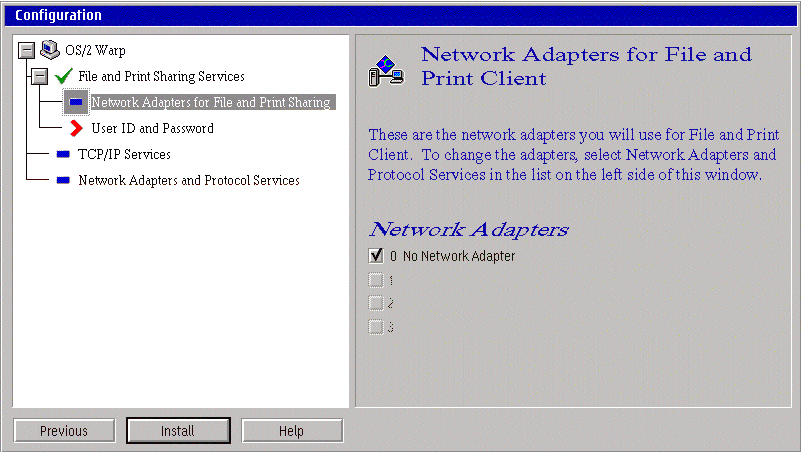
Could that title be a little longer? Isn't it redundent with "Network Adapters and Protocol Services"? So, you see that this dialog doesn't do very much, either I deselect "No Network Adapter" and get an error, or I leave it as it is. OK, this must be where people say "OS/2 is so hard to configure". I'll give that one up. Next!
User ID and Password
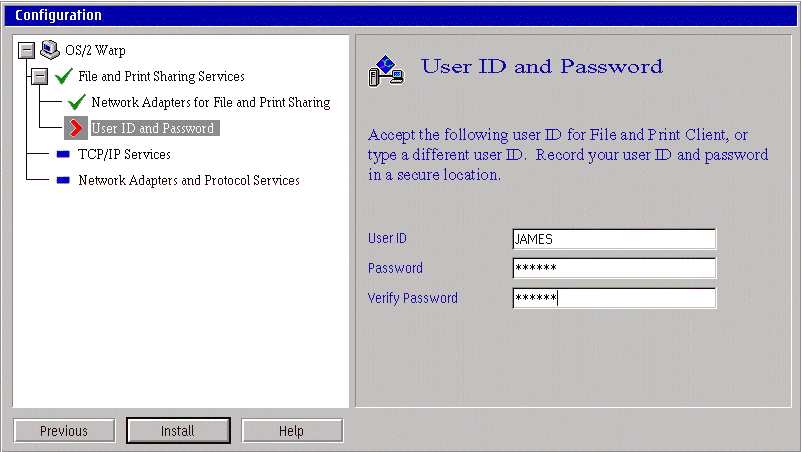
This is what I call a "no brainer", unless you are prone to forget you're password. Use something reasonable. This isn't some corporate strategy session, just use your first name. Unless, everyone has the same name, then maybe a variation. Use common sense, but you were going to do that anyways.
TCP/IP Services
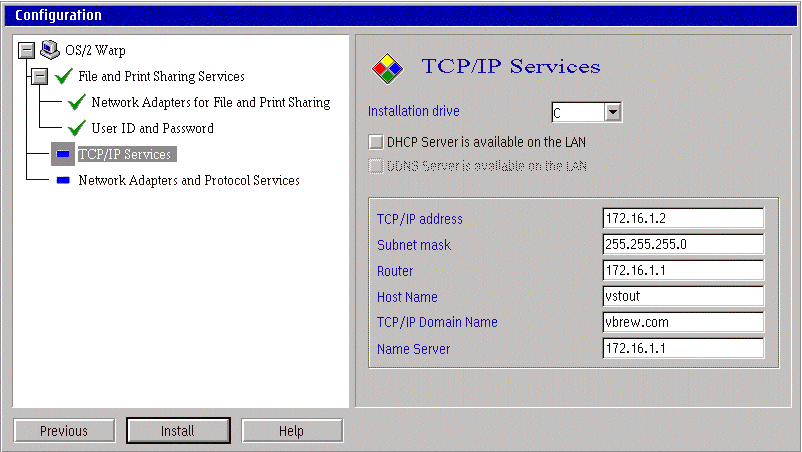
OK, this is where you may need help. I'm a little odd, in that I'm using a class B network, and not a class C network. What's the difference? It depends whether you need more than 256 separate addresses (including broadcast and network). I really don't want to go into a discusion about TCP/IP. Most of this will be from your admin (you!). If you are off the internet or behind a firewall, you can use an exclusive (I love that word) set of IP addresses. Class A: 10.0.0.0, Class B: 172.16.0.0 through 172.31.0.0, and Class C: 192.168.0.0 through 192.168.255.0. My "Router" and "Name Server" are my both my Linux box (that's what IBM uses right? Move over AIX.) The "Host Name" and "TCP/IP Domain Name" are still that familiar vstout.vbrew.com found in the aformentioned book. NOTE: OS/2 has routed (Route Daemon), so you could even use the same TCP/IP address, as long as this service is configured and running. Does that mean OS/2 can be a router? Yes! OK, let's move on before I lose track. Please direct questions to the forum.
Network Adapters and Protocol Services

Everything here is configured, right? Wrong! We need an adapter! So, please select "Add adapter...". You do have your network card's diskette handy, right? If not, now is a good time to have it ready. Onward!
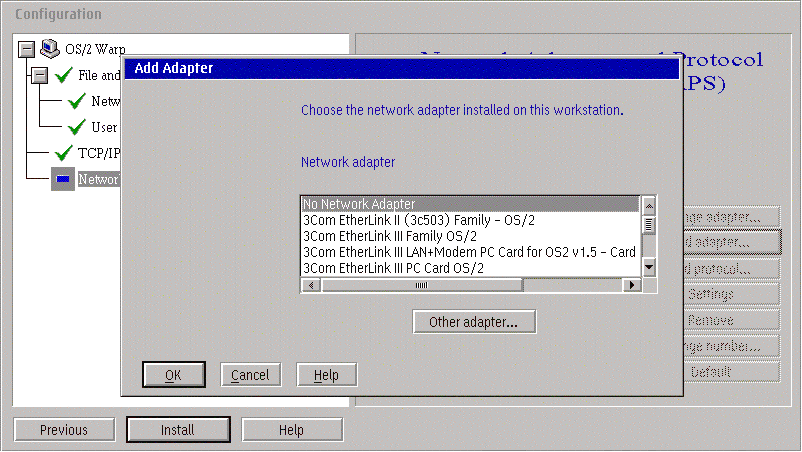
If you have an old adapter (10BaseT or 10Base2 AKA "coax"), you may already be in luck. For me, I had my diskette ready. I also ensured the network adapter card (NIC) was supported before I bought it. So, I needed to select "Other adapter...".
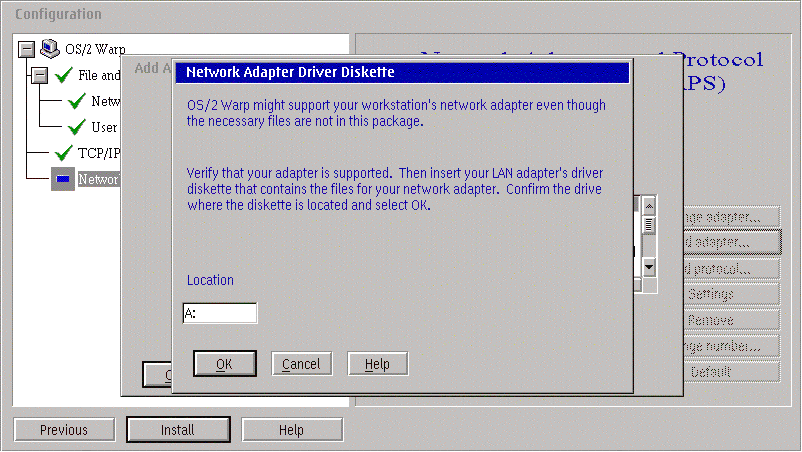
Mine was in the A: drive. You may have a CD, or a file downloaded in some location on your hard drive (C:\My Downloads, yuck!).
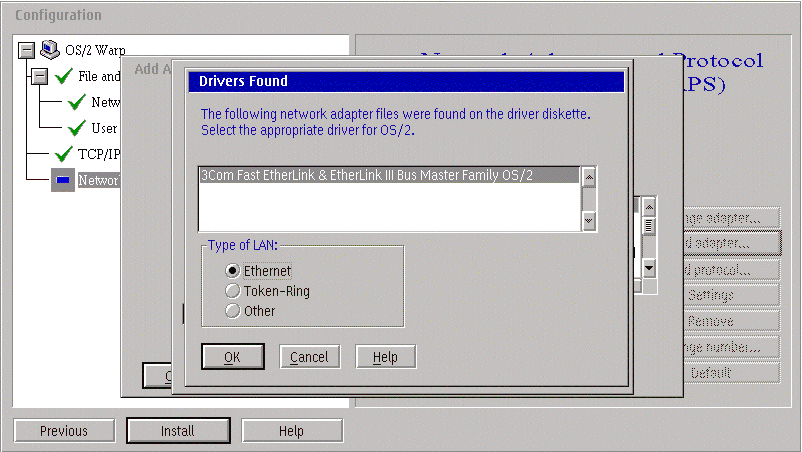
I was happy that OS/2 recognized the driver and went with it.
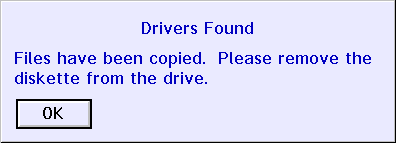
Then the dumbest dialog shows up (please compare it to the previous). I was pretty sure it was recognized earlier. Wouldn't a progress bar be more appropriate? Hopefully one I don't have to peck at like a chicken? OK, I'm going off, but I'm almost done.
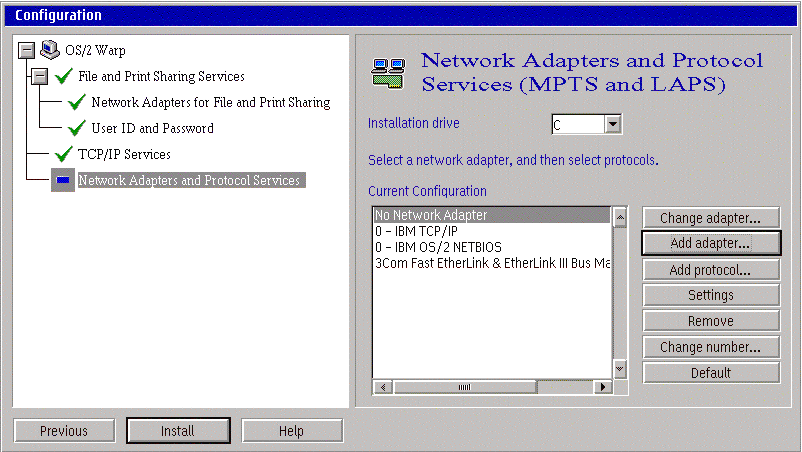
Now the house is full. If you want to route your peer networking, you'll want to add another protocol, "Netbios over TCP/IP", or some such nonsence. I didn't. It's a security whole for the world to enjoy. I also don't want Windows blasting my Linux/Unix systems. If you do feel foolish, and don't want to use Unix networking that much, be sure to set it with a different number ("Change number..."). I skipped that, please go to the forum. If you'v got Windows XP, you will need it, or you will need to add NETBIOS to Windows XP.
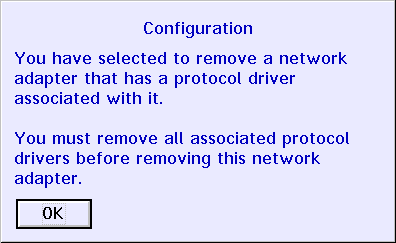
This is the message you'll see if you try to get rid of "No Network Adapter". So, you may see a problem here. Remove the protocols, then remove the "No Network Adapter" (AKA the modem). But if you're on LAN only, remove the protocols, then the "No Network Adapter", then add the protocols back to the new network card you have just installed, and configure. (I lost this screen shot, whoops. Something always falls to the wayside.) Now you're ready to press the Install button to set everything up.
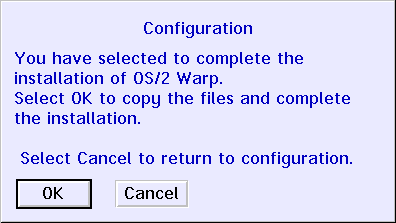
Success!
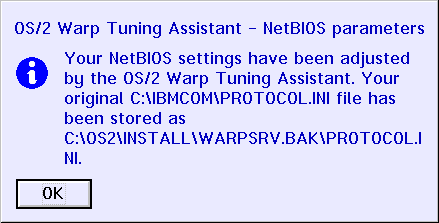
Information, etc. Move on!
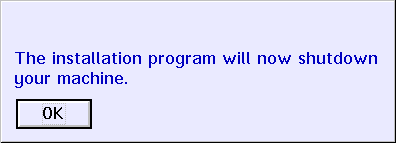
Make no doubt about it. The system will come up, process some files and reboot a second time. If you're lucky, you'll see some text messages about your device driver. I did. That's a lot for now. Maybe me or some else will follow-up with the Connections folder.
References
"LAN Administration Guide""File and Print Client Guide"
"TCP/IP Guide" (OS/2 Warp 4 Desktop -> Assistance Center -> Information -> Tasks: )
"Linux Network Administrator's Guide", Olaf Kirch, O'Reilly & Associates, INC., January 1995: First Edition. <- Highly recommended.
"OS/2 Warp Administrators's Survival Guide", Kerr, Curran, et al., Sams Publishing, 1995: First Edition. <- Get it if you can find it (mine's not for sale!).
Terms
AKA - Also known as.IMHO - In my humble opinion.
TCP/IP - Transmission Control Protocol / Internet Protocol * Not TCPIP! There are two protocols. You can use UDP/IP with some applications.
NETBIOS - Network basic input output service.
|
Previous Article |
|
Next Article |